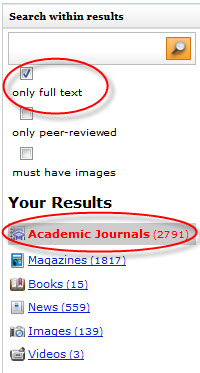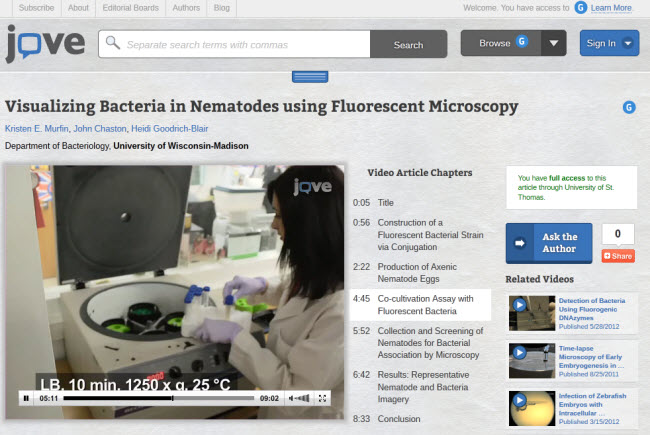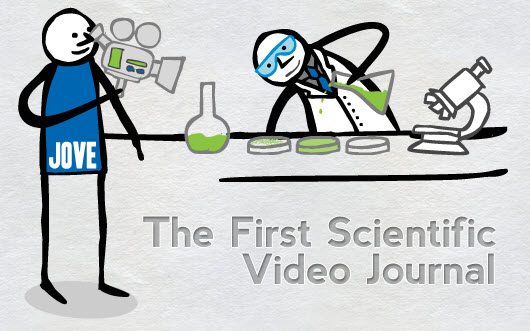Genera l Science Collection is a database of full-text of science journals. It is provided free from the state through the Electronic Library of Minnesota (ELM). I am pleased to announce that the product has become far less general and far more peer-reviewed. What was a database of mostly general science magazines has now become a database of mostly peer-reviewed scholarly journals in the sciences. When you search the results default to full text academic journals. You can narrow those results to peer-reviewed journals only, or only magazines, news and even videos.
l Science Collection is a database of full-text of science journals. It is provided free from the state through the Electronic Library of Minnesota (ELM). I am pleased to announce that the product has become far less general and far more peer-reviewed. What was a database of mostly general science magazines has now become a database of mostly peer-reviewed scholarly journals in the sciences. When you search the results default to full text academic journals. You can narrow those results to peer-reviewed journals only, or only magazines, news and even videos.
science
Attention all UST sky-watchers: If you haven’t heard of it yet, a new comet will soon be making its debut in the Northern hemisphere!
Called Comet PanSTARRS, it was discovered back in June 2011 by the Panoramic Survey Telescope & Rapid Response System (Pan-STARRS) based at the University of Hawaii’s Institute for Astronomy.

photo credit: www.skyandtelescope.com
Since its discovery, the comet has been slowly heading toward the inner solar system on its way to reaching its closest point to the sun, known as perihelion, which will occur on March 10.
In early February, people in Australia started taunting us with their great pictures as it was seen for the first time with a naked eye from the Southern Hemisphere. It has continued on its way north, though, and on March 12, comet PanSTARRS will pass into Northern Hemisphere skies.

photo credit: Luis Argerich – Nightscape Photography
The best times to look will be on the evenings of March 12th and 13th. On those evenings you can use the crescent Moon as a guide to help you find PanSTARRS. On the 12th the comet will be to the Moon’s upper left. On the 13th, the comet will be to the Moon’s lower right. If the skies are clear, you should be able to see it with a naked eye somewhat close to the horizon, although binoculars will definitely help to see the tail more clearly.
Busy those nights? No worries: if you miss it, you will only have 110,000 years to wait for its next appearance!
(Or you can wait a few months to see another comet; Comet ISON, predicted to be even brighter, is hot on its heels in November. We’ll be sure to keep you posted when it comes near!)
Want to read more? Check out some great coverage in our library databases and at Sky and Telescope.com
Journal of Visual Experiments (JoVE) Available Online via UST Libraries
 The Chronicle of Higher Education has a nice article on the online Journal of Visual Experiments (JoVE). JoVE is an entirely new scholarly publication format, combining journal article and video documentary of scientific experimental methods.
The Chronicle of Higher Education has a nice article on the online Journal of Visual Experiments (JoVE). JoVE is an entirely new scholarly publication format, combining journal article and video documentary of scientific experimental methods.
The UST Libraries recently subscribed to this video journal to support our science disciplines. Note that while the Chronicle article mentions that JoVE is published in five topical and one general section, UST at this time can only afford to subscribe to the general section (watch for the “G” icon in search results). Articles from JoVE are indexed in PubMed and other indices.
Each article presents citation information, an abstract, links to video “chapters”, and other features in addition to the video article itself. JoVE is available via our databases page, the Journals A-Z list, several science discipline research guides, and directly at: http://www.jove.com.ezproxy.stthomas.edu/general.


Core Curriculum – Natural Science and Mathematical and Quantitative Reasoning
 Let’s say you barely made it through high school biology and now you’re faced with college biology. Well, have no fear! We got sources that’ll explain science things for non-science majors.
Let’s say you barely made it through high school biology and now you’re faced with college biology. Well, have no fear! We got sources that’ll explain science things for non-science majors.
These sources cover ALL sciences and will most likely be useful for any of he natural science or mathematical or quantitative reasoning classes you may have:
- Science Reference Center will work for all things science (articles, encyclopedias, dictionaries, etc).
- JoVE offers videos of biological, medical, chemical and physical research. So just in case you’re assigned to describe a push-pull method for collecting plant volatiles, JoVE’s got that video.
- VAST offers documentary videos, as does Films on Demand. Thousands of videos on biology, earth science, environmental science and health and medicine.
But for specific classes I offer…
BIOL 101 General Biology
BIOL 102 Conservation Biology (also good for GEOL 1xx classes)
BIOL 106 Women, Medicine & Biology
CHEM 100, 101, 111, 112, 115
- Lange’s Handbook of Chemistry Lange’s Handbook of Chemistry includes data for each compound including name, structural formula, formula weight, density, refractive index, melting point, boiling point, flash point, dielectric constant, dipole moment, solubility in water and relevant organic solvents, thermal conductivity and electrical conductivity.
- SciFinder SciFinder provides easy access to information in Chemical Abstracts Services resources: journal citations and abstracts, substance data, chemical reactions, regulatory data, chemical suppliers, and biomedical literature. Sign up for an individual account.
Now I realize there are probably many, many other classes that fulfill the natural science, math and quantitative reasoning requirement. I’ve missed more than a couple of them I am sure. If you are in a class that meets the core requirement and don’t see anything here that would help you, see if you can find related resources on our SCIENCE pages. If those don’t work, check out the research guides in the various disciplines.
We tell the students who we teach about using library resources that they should limit their research to peer reviewed journals for many topics. Particularly in the sciences. Many of our databases, Academic Search Premier, Expanded Academic and our mega-search tool, Summon, limiting to peer reviewed scholarly resources is a choice. The Chronicle of Higher Education is reporting on an incident that took place in 2001. GlaxoSmithKline paid a ghost writer to write a paper that was accepted for publication in the peer review, Journal of the American Academy of Child and Adolescent Psychiatry, Vol. 40, (7) 2001 762-772. GlaxoSmithKline admitted its guilt and has paid 3 BILLION dollars, yes BILLION with a B. According to the Chronicle article, Paxil made over 11 billion dollars ust between 1993 and 2007.
The purported 22 authors were not from Podunk U (apologies to Podunk). These were people from Brown (who will not comment); University of Pittsburgh; UCLA; New York University; Dalhousie University; University of Pennsylvania; State University of New York at Stony Brook; Center for Health Research, Portland, OR; University of Texas; Washington University, St. Louis (my alma mater, tsk tsk); Grace-1WK Hospital, Halifax; University of Toronto; Oregon Health Sciences University; New York State Psychiatric Institute; Children’s Hospital of Philadelphia. The list reads like the who’s who in major research universities. And nothing is happening to the researchers who have gone on to have prestigious positions at major universities, holding named positions, editors of journals and publishing in large quantities. Nothing is happening to this ‘prestigious’ journal NOR is the article being retracted. Did you know there is a Medical Subject Heading for Retracted articles? AND something allegedly did happen to the children who took this drug when it is not recommended for people under 18. Suicide. That’s the real tragedy here.
 In 2008 the book Side Effects: A Prosecutor, a Whistleblower, and a Bestselling Antidepressant on Trial by Allison Bass was published. There are two copies in CLICnet. It documents this event.
In 2008 the book Side Effects: A Prosecutor, a Whistleblower, and a Bestselling Antidepressant on Trial by Allison Bass was published. There are two copies in CLICnet. It documents this event.
For me, having been an academic medical librarian for 26 years prior to going to general academic libraries this admission does more than just put this article and these people into doubt. It puts the process into doubt. If they thought they could get away with this, and they did for 11 years, it must be rampant in the scientific community. Oh, we’ll just let the drug maker write it up for us! We’ll get the credit, it will support our advancement and tenure documents, we’ll get more government grants. It makes me feel that a Wikipedia article gets more scrutiny than a journal article in a prestigious journal. OK, kids, just go to Wikipedia. Watch out for the article by Keller, et. al. (That’s more warning than any article that cites that 2001 article gives.)
Places & Spaces: Mapping Science is a cool set of physical exhibits featuring infographics and maps that are also browseable online. From the website: “Places & Spaces: Mapping Science is meant to inspire cross-disciplinary discussion on how to best track and communicate human activity and scientific progress on a global scale. It has two components: the physical part supports the close inspection of high quality reproductions of maps for display at conferences and education centers; the online counterpart provides links to a selected series of maps and their makers along with detailed explanations of how these maps work. The exhibit is a 10-year effort. Each year, 10 new maps are added resulting in 100 maps total in 2014.”
See the exhibits/maps organized around their annual themes (listed below) or browse them all.
The exhibit is a 10-year effort. Each year, 10 new maps are added resulting in 100 maps total in 2014.
1st Iteration (2005): The Power of Maps
2nd Iteration (2006): The Power of Reference Systems
3rd Iteration (2007): The Power of Forecasts
4th Iteration (2008): Science Maps for Economic Decision Makers
5th Iteration (2009): Science Maps for Science Policy Makers
6th Iteration (2010): Science Maps for Scholars
7th Iteration (2011): Science Maps as Visual Interfaces to Digital Libraries
8th Iteration (2012): Science Maps for Kids
9th Iteration (2013): Science Maps for Daily Science Forecasts
10th Iteration (2014): Telling Lies with Science Maps
Listen to a podcast about the project or see a short YouTube video clip :